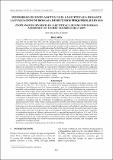Por favor, use este identificador para citar o enlazar este ítem:
https://hdl.handle.net/20.500.12958/5874Registro completo de metadatos
| Campo DC | Valor | Lengua/Idioma |
|---|---|---|
| dc.contributor.author | Flores Chambi, Ana Julia | - |
| dc.date.accessioned | 2022-11-18T19:43:53Z | - |
| dc.date.available | 2022-11-18T19:43:53Z | - |
| dc.date.issued | 2022-12 | - |
| dc.identifier.citation | Flores, A. (2022). Diversidad de zooplancton en el lago Titicaca durante la evaluación de biomasa de recursos pesqueros, julio 2019. Inf Inst Mar Perú. 49(4): 552-569. | es_ES |
| dc.identifier.issn | 0378-7702 | - |
| dc.identifier.uri | https://hdl.handle.net/20.500.12958/5874 | - |
| dc.description.abstract | En julio 2019 y durante la evaluación de biomasa de recursos pesqueros y limnología del Lago Titicaca se colectaron 116 muestras de zooplancton, los que se identificaron y cuantificaron a nivel de género. Se reporta diversidad y distribución del zooplancton, densidad y distribución de grupos tróficos y el efecto de variables abióticas. Se identificaron 15 géneros de rotíferos, 6 de cladóceros, 3 de copépodos. Los nauplii predominaron en el lago Titicaca, seguidos por rotíferos y cladóceros, los rotíferos fueron más variables en densidad. En el Lago Menor, la variabilidad es atribuida al aporte de nutrientes alóctonos y a su condición de lago somero, en el Lago Mayor la escasa variabilidad se atribuye al aporte de las poblaciones aledañas. Como estaciones más diversas se identifican a isla Taquiri, orilla del Pomata y de Guaqui, salida de los ríos Coata y Tilali, las menos diversas están en la Fosa de Chúa y el centro del transecto Copacabana-Ancoraimes. El grupo trófico más abundante y con más variabilidad fueron pequeños herbívoros del Lago Menor, los grandes herbívoros fueron más representativos en la salida del río Coata y en la parte sur oeste del Lago Menor, los carnívoros están presentes solo en algunas estaciones del Lago Mayor. Las variaciones en densidades de zooplancton a diferentes profundidades se dieron para copépodos entre las profundidades de 5, 10, 20-30 m respecto de la superficial de 0,5 m, y de las profundidades de 50-70 y >100 m. El viento pudo homogenizar la columna de agua, sobre todo en los primeros metros e impedir la estratificación del zooplancton. No se encontró relación importante entre variables fisicoquímicas, nutrientes y clorofila con el zooplancton ni con los grupos tróficos. | es_ES |
| dc.description.abstract | ABSTRACT: We carried out a biomass assessment of fishery resources and limnology of Lake Titicaca in July 2019. During our study, a total of 116 zooplankton samples were collected, identified, and quantified to genus level; also, we reported the diversity and distribution of zooplankton, as well as such of the trophic groups and the effect of abiotic variables. In all, we identified 15 genera of rotifers, 6 cladocerans, and 3 copepods. Nauplii predominated in Lake Titicaca, followed by rotifers and cladocerans; rotifers were more variable in density. The variability in Lake Titicaca’s shallow sub-basin is due to the contribution of allochthonous nutrients and its condition as a shallow lake; in its deep main basin, the scarce variability is associated with the contribution of neighboring populations. The most diverse stations are Taquiri Island, the shores of the Pomata and Guaqui rivers, and the outlet of the Coata and Tilali rivers, while the Chúa Trench and the center of the Copacabana-Ancoraimes transect are the least diverse stations. Small herbivores were the most abundant and most variable trophic group in the shallow Lago Menor sub-basin, large herbivores were more representative in the outlet of the Coata river and the southwestern part of Lago Menor, while carnivores were present only in some stations of the deep Lago Mayor main basin. Variations in zooplankton densities at different depths occurred for copepods between the depths of 5, 10, and 20-30 m compared to the shallow depth of 0.5 m, and the depths of 50-70 and >100 m. The water column may have been homogenized by the wind, especially in the first few meters, and prevented zooplankton stratification. No significant relationship was found between physicochemical variables, nutrients, and chlorophyll with zooplankton or trophic groups. | - |
| dc.language | spa | spa |
| dc.language.iso | spa | es_ES |
| dc.publisher | Instituto del Mar del Perú | es_ES |
| dc.relation.ispartofseries | Informe IMARPE 49(4), 2022; | - |
| dc.rights | info:eu-repo/semantics/openAccess | es_ES |
| dc.rights.uri | https://creativecommons.org/licenses/by/4.0/ | es_ES |
| dc.source | Instituto del Mar del Perú - IMARPE | es_ES |
| dc.source.uri | Repositorio Digital IMARPE | es_ES |
| dc.subject | Zooplancton | es_ES |
| dc.subject | Grupos tróficos | es_ES |
| dc.subject | Diversidad | es_ES |
| dc.subject | Lago Titicaca | es_ES |
| dc.title | Diversidad de zooplancton en el lago Titicaca durante la evaluación de biomasa de recursos pesqueros, julio 2019 | es_ES |
| dc.title.alternative | Zooplankton diversity in Lake Titicaca during the biomass assessment of fishery resources (July 2019) | es_ES |
| dc.type | info:eu-repo/semantics/article | es_ES |
| dc.publisher.country | Perú - Callao | es_ES |
| dc.subject.ocde | http://purl.org/pe-repo/ocde/ford#1.06.12 | es_ES |
| Aparece en las colecciones: | Informe vol. 49(4) 2022 | |
Ficheros en este ítem:
| Fichero | Descripción | Tamaño | Formato | |
|---|---|---|---|---|
| Informe 49-4 artículo 6.pdf | 1,45 MB | Adobe PDF |  Visualizar/Abrir |
Este ítem está sujeto a una licencia Creative Commons Licencia Creative Commons

